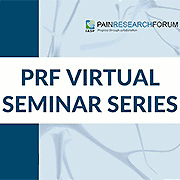Editor’s note: This seminar is the latest event in a series of seminars launched in May 2020 to help keep the pain research community connected during the COVID-19 pandemic and to provide all members of our community with virtual educational opportunities. The seminar series is supported by the Center for Advanced Pain Studies at the University of Texas at Dallas, US.

On December 18, 2020, the IASP Pain Research Forum hosted a seminar with Biafra Ahanonu, PhD, and Jarret Weinrich, PhD, both of the University of California, San Francisco, US. A Q&A session moderated by Gregory Scherrer, PhD, University of North Carolina School of Medicine, Chapel Hill, US, followed the presentation.
A recording of this webinar will soon be freely available to IASP members at the IASP Pain Education Resource Center (PERC).
Here are abstracts from the presenters:
Neural Dynamics of Pain in Behaving Animals Using in Vivo Recording and Computational Techniques (Biafra Ahanonu)
An unpleasant percept dominates the affective component of pain, which provides a motivational drive to initiate protective behaviors that limit exposure to noxious stimuli. Detailed mechanisms of how noxious inputs are transformed into appropriate behavioral outputs remain unclear. I will discuss in vivo freely moving calcium imaging experiments that show that a noxious stimuli-responsive amygdalar neural ensemble codes for pain, and that a subset of this ensemble is stable across days to weeks. We find that heightened behavioral responses after nerve injury parallel alterations in the neural pain code, and that this neural ensemble is necessary to produce affective-motivational, but not reflexive, pain behaviors. This suggests a therapeutic route to reduce the unpleasant aspect of pain while retaining the critical sensory and reflexive components. I will then feature ongoing and future studies using neural recording in awake animals and large-scale molecular analysis to understand how information is processed and relayed at multiple nodes of the pain neuroaxis. Lastly, I briefly highlight enhanced calcium imaging analysis using our CIAtah (pronounced cheetah) software package along with methods for log-likelihood-based calcium imaging cell extraction and machine learning-based automated cell classification that create a widely applicable computing pipeline for systems neuroscience.
Imaging Cortical Circuitry During General Anesthesia: Insights Into Cortical Pain Processing (Jarret Weinrich)
General anesthetics work in a concentration-dependent manner on the central nervous system (CNS) to induce loss of consciousness and block the experience of pain. Interestingly, however, with nitrous oxide anesthesia and during the initial stages of diethyl ether anesthesia, analgesia (namely, pain relief) can be produced independently of loss of consciousness. In contrast, isoflurane and sevoflurane, which are halogenated ethers, unquestionably produce unconsciousness, but produce little to no pain relief. Despite 150 years of research into general anesthesia, including advances in our understanding of underlying molecular targets, almost nothing is known about the neural circuits through which general anesthetics block pain. By simultaneous in vivo monitoring of the spontaneous activity of hundreds individual neurons in awake, freely moving mice during the inhalation of general anesthetics that do (nitrous oxide) or do not (isoflurane) produce analgesia, we have discovered that general anesthetics induce paradoxical changes in neural activity in the anterior cingulate cortex (ACC), a region that is implicated in the affective/emotional, but not the sensory/discriminative, component of the pain experience. Our results not only provide new insights into the mechanisms through which general anesthetics alter pain perception, but also suggest new approaches to altering the perception of pain by manipulating specific brain circuits.
About the presenters
Biafra Ahanonu, PhD, obtained his B.Sc. from Massachusetts Institute of Technology (biology, and brain and cognitive sciences) and his PhD from Stanford University (biology, under the mentorship of Dr. Mark Schnitzer). He is currently a postdoctoral scholar in Dr. Allan Basbaum’s lab at UCSF focused on molecular properties and coding principals of pain-related neural circuits in normal and diseased states. In addition, he develops new tools for calcium imaging analysis, such as CIAtah. Find out more about him.
Jarret Weinrich, PhD, completed his graduate training at the Weill Cornell Graduate School of Medical Sciences at Cornell University, and is currently a postdoctoral fellow in the laboratory of Dr. Allan Basbaum, PhD, at the University of California, San Francisco. His postdoctoral work focuses on using in vivo neural circuit imaging technology to investigate how general anesthetics alter the perception of pain.
About the moderator
Gregory Scherrer, PhD, is an associate professor at the University of North Carolina (UNC) at Chapel Hill in the Department of Cell Biology and Physiology and Neuroscience Center. Since 2017, Dr. Scherrer is a New York Stem Cell Foundation Robertson Investigator in Neurosciences. Dr. Scherrer received his PhD in cellular and molecular biology from the University of Strasbourg, France, in 2005. He then completed postdoctoral trainings at UCSF and Columbia University, studying the neurobiology of pain, and the physiology of the spinal cord dorsal horn, respectively. In 2012, he joined the faculty at Stanford University as an assistant professor in the Departments of Anesthesiology, Molecular and Cellular Physiology, and a member of the Stanford Wu Tsai Neurosciences Institute, until he joined UNC in September 2019. His lab investigates the organization of the neural circuits and molecular mechanisms that underlie pain perception and the effects of opioids. His team studies the sensory, affective, and cognitive dimensions of pain, and both the analgesic and side effects of opioids. He uses the mouse as a model system, and approaches such as mouse genetics, transcriptomics, circuit tracing, slice electrophysiology, opto/chemogenetic manipulation of neural activity, imaging of calcium dynamics in freely moving mice, and behavioral assays. Dr. Scherrer’s long-term goal is to develop innovative therapeutic strategies to mitigate opioid side effects and to treat pain more effectively and safely.
New in 2021!
As of January 1, 2021, IASP is completing the merger of PRF, which we started several years ago. PRF seminars will now be available to IASP members free of charge as an added member benefit. So if you’re a member, this becomes another great benefit. If you’re not an IASP member and are looking for even more educational content about pain, this is the perfect opportunity to join IASP so that you will have access to the seminars and other valuable content.
Membership includes, but is not limited to the following:
1. Access to PAIN and PAIN Reports
2. Discounts to IASP World Congress and Virtual Series
3. Opportunities to join Special Interest Groups (SIGs)
4. Free access to the Pain Education Resource Center (PERC)
5. Online Career Center
If you’re not interested in joining, there will be a registration fee for non-IASP members, with more details to follow.
To learn more about membership, please visit here or contact IASPDesk@iasp-pain.org.
Join the conversation about the seminar on Twitter @PainResForum #PRFSeminar
We thank the Center for Advanced Pain Studies at the University of Texas at Dallas, US, for its support of the PRF seminar series.



